
An anthem about a restless search for identity and escape from the gilded cage of teen stardom.
For those of us who came of age with a feathered haircut and a Shaun Cassidy poster on the bedroom wall, the late 1970s were an exhilarating, if fleeting, era of unbridled teen pop. But beyond the bubblegum hits like “Da Doo Ron Ron” and “That’s Rock ‘n’ Roll,” there were deeper cuts, tracks that offered a glimpse into the restless heart and evolving artistry of the young idol himself. One such song, a true anomaly in his pop catalog, is “Break for the Street.”
This track was a moment of self-assertion, an original composition written and co-produced by Shaun Cassidy himself, and it was the opening song on his fourth studio album, Room Service, which was released in 1979. By this point, the initial frenzy of Cassidymania was beginning its inevitable descent. After the massive multi-platinum success of his first two albums, Shaun Cassidy and Born Late, the 1978 follow-up, Under Wraps, sold a million copies but signaled a shift. Room Service itself failed to chart on the US Billboard 200, and consequently, “Break for the Street” was not released as a single and did not have a chart position in the way his earlier hits had. It was, instead, a stylistic declaration on an album that marked a critical turning point for his artistic career.
The meaning of “Break for the Street” is an attempt to break free from the carefully manicured image of a wholesome teen idol. The song is a blast of what critics at the time considered a “tougher” or “ballsier” rock sound, a stark contrast to the sugary pop confections he was known for. It’s a rock-and-roll song about the yearning for authenticity—a desire to trade the velvet rope of fame for the rougher, realer pavement of the outside world. This story behind the song is less about a literal journey and more about an internal struggle. Cassidy, surrounded by the artifice of teen celebrity, was trying to convey an appetite for something real. He was an artist seeking to shed the character of “Joe Hardy” from The Hardy Boys/Nancy Drew Mysteries and the commercialized innocence of his chart-topping singles.
Listening to it now, that unvarnished ambition resonates powerfully. It’s the sound of a young man, a serious musician at heart, trying to prove his chops to a skeptical music world that saw him only as a manufactured product. The track’s energy—its driving guitar and earnest, slightly rougher vocal delivery—stands as an early signal of the sonic evolution that would fully bloom on his final album, 1980’s Wasp, which was produced by Todd Rundgren and featured the band Utopia.
It’s a song that asks, “Is there more to me than what you see on the magazine cover?” For those of us who grew up following his career, “Break for the Street” felt like a whispered confidence—a moment where Shaun Cassidy was telling his most devoted fans, “I’m changing, and I hope you’ll come with me.” It may not have been a chart hit, but it was a crucial step on Shaun Cassidy’s long, winding road from teen pin-up to the respected writer and producer he is today. It’s a nostalgic look back at a time when even the most dazzling pop stars had to fight to find their own voice.